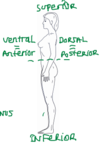Body Plan Flashcards
Label this picture

- Dorsal
- Ventral
- Mouth
- Anus
- Cross Section

Label Diagram

- Superior
- Dorsal=posteriror
- Inferior
- Ventral=anterior

What does being in “Prone”?
On the belly
Outer Tube aka_______ and _______
Body
Soma
Somatic aka______
parietal
what kind of muscles and motor neurons are found in outer tube?
Striated Skeletal muscle
Somatic Motor Neurons
The Somatic part of the body is made up of Striated Skeletal Muscle and is innervated by somatic motor neurons
The body cavity is also known as______
coelom
“potential space”
Inner tube also known as ______ and _______
gut tube
viscera
Visceral is also known as ________
splanchnic
what kind of muscles and motor neurons are found in the inner tube?
- smooth and cardiac muscle
- visceral motor neurons
The visceral part of the body is made up of smooth muscle and cardiac muscle and they are innervated by visceral motor neurons
_________make up the autonomic nervous system
Visceral motor neurons make up the autonomic nervous system.

Label this picture

- Outer tube
- Soma
- Parieta
- Body Cavity
- Coelom
- Inner Tube
- Viscera
- Splanchnic

________has the palms facing foward
Anatomical position has the palms facing forward.
Name the plane-cross section of the human body?

- Sagital/midline
- Coronal/frontal
- Transverse/horizontal/cross-section

Label the blank

Diaphragm= transverse septum













